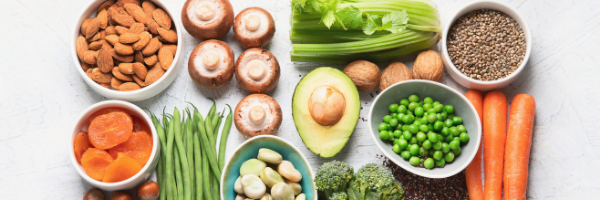 Notes on diet for hemochromatosis:
Notes on diet for hemochromatosis:
The most important things to avoid:
- Iron supplementation
- Fortified foods with iron &/or vitamin C
- Vitamin C supplements
- Red meat, shellfish (or consume very infrequently and pair with calcium-rich foods)
- Alcohol
The most important things to add into your diet:
- Fruits and vegetables
- Whole plant foods
- Everything in the “Consume” and “Limit” categories above
The most important things to know about pairing your foods to limit iron absorption:
Firstly, please know that the current medical therapies you are doing are the most effective for managing hemochromatosis. Next, “the most important things to avoid,” is the next most supportive piece to the equation. Lastly, food pairing and choices are somewhat supportive, but the first two will be the most important. Because plant foods, namely vegetables, have a combination of calcium, vitamin C, iron and other nutrients, they will not have as large of an effect on managing hemochromatosis as the above mentioned. You will notice that some foods are listed in both categories. This is not to confuse you, but rather to show that some of these foods will have multiple of these nutrients. It may be helpful to think of the foods in both categories (ie broccoli) as neutral when pairing.
- Calcium-rich foods will inhibit heme and non-heme iron absorption. If you chose to consume non-heme iron sources (plant foods) on occasion, which is harder for the body to absorb than heme sources, you could pair it with some calcium-rich foods. For example, spinach with organic, grass fed yogurt and chia seeds in a morning smoothie.
- Yogurt, kefir, cheese, tempeh, broccoli, leafy greens, broccoli, chia seeds, almonds, dried figs, white beans, sunflower seeds, edamame, kale, sesame seeds, collard greens, etc.
- Vitamin C-rich foods support iron absorption. Here is a list to help with potential food pairing. Please note that vitamin C is an important nutrient and antioxidant that is necessary to include in your diet.
- Peppers, cherries, thyme, parsley, kale, kiwi, broccoli, brussel sprouts, lemons, strawberries, oranges
Consume:
- Vegetables & Fruits
- 2-3 cups of Leafy Greens daily (Kale, Chard, Arugula, Bok Choy, etc.)
- 2-3 cups of Sulphur daily (Onion, Garlic, Broccoli, Cabbage, Asparagus, Mushrooms, etc.)
- 2-3 cups Colorful daily (Berries, Beets, Carrots, etc.)
- 1-2 handfuls of berries daily
- Whole Grains & Legumes
- 1.5 cups of cooked Whole Grains daily (Barley, Brown/Wild Rice, Buckwheat, Millet, Oats, Quinoa, etc.)
- 1.5 cups of cooked Legumes daily (beans, peas, lentils, etc.)
- Seeds & Nuts
- ¼ cup Seeds or Nuts daily (Almonds, Brazil Nuts, Chia Seeds, Hemp Seeds, Pistachios, etc.)
- Fish, Game, Poultry (optional)
- 1-3 servings of wild-caught Fish or Seafood per week (Wild-Caught)
- 1-2 servings of organic, grass-fed Game or Poultry per week (Turkey, Chicken, Quail, Pheasant, Rabbit, etc.)
- Herbs & Spices
- Unlimited salt-free and sugar-free Herbs and Spices (Basil, Bay Leaves, Turmeric, Chili Powder, Rosemary, etc.)
- Herbal Tea
- Unlimited amounts of Herbal Tea (Chamomile, Peppermint, Raspberry, etc.)
- Water
- Drink half of your weight in ounces daily
- Pure water without contaminants
Limit:
- Fats
- (Can consume healthy fats – Extra Virgin Olive Oil, Avocados, Full-Fat Coconut Milk, Seeds, Nuts, etc. in moderation)
- Eggs
- 2-3 serving of organic, pasture-raised Eggs per week
- Caffeine
- 1-2 cups of Caffeinated Beverages per day (i.e. green tea)
- Dairy
- (Yogurt, kefir, cheese, etc.)
Avoid:
- Meat, Red Meat
- (Heavily processed meats)
- Alcohol
- Fried Foods
- (French Fries, Burgers, Chicken Nuggets, Onion Rings, Chips, etc.)
- Processed Foods
- White Flours and Sugars (Cakes, Breads, Donuts, Ice Cream, Cookies, etc.)
- Sodas (all sodas, energy drinks, etc.)
- Packaged Products
- Added Sugars
- Added Sugars (sodas, sauces, breads, etc.)
- Tobacco & Environmental Toxins
- Tobacco products (cigarettes, nicotine, vaporizers, chew/ dip, etc.)
- Environmental Toxins (pesticides, herbicides, cleaning chemicals, chemicals in body-care products, etc.)
Sample Eating Schedule
1:00-6:00 Fast
7:00 Break Fast
- Steel cut oats with berries, nuts and seeds
- Protein shake with vegetables, fruits, seeds &/or nuts (grass-fed/organic collagen, whey or egg protein powders)
- Chia seed pudding with berries and nuts
- Vegetable hash
10:00 Snack (optional)
- Chopped vegetables
- Handful nuts
- Handful berries
12:00 Lunch
- Salad (vegetable assortment, legumes, seeds, nuts, healthful dressing)
- Soup (bone broth, vegetable assortment, legumes, beans, herbs & spices, optional poultry/fish)
15:00 Snack (optional)
- Chopped vegetables
- Handful nuts/ seeds
- Handful olives
- Two small slices of cheese (occasionally)
17:00 Dinner
- Soup (bone broth, vegetable assortment, legumes, beans, herbs & spices, optional poultry/fish)
- Homemade burrito bowl (rice, beans, vegetable assortment, guacamole, optional poultry/fish)
18:00-24:00 Fast
Last notes:
I really want to emphasize that consuming lots of fruits and vegetables high in antioxidants and nutrients is extremely important to combat free radicals caused from oxidation. Continuing your recommended medical therapies and following “the most important things to avoid” and “the most important things to add into your diet” are the best steps for management. The pairing of vitamin C and Calcium-rich foods without or with iron is the least important of all of these pieces to the puzzle. It may be beneficial, but that has yet to be studied further in scientific literature.
